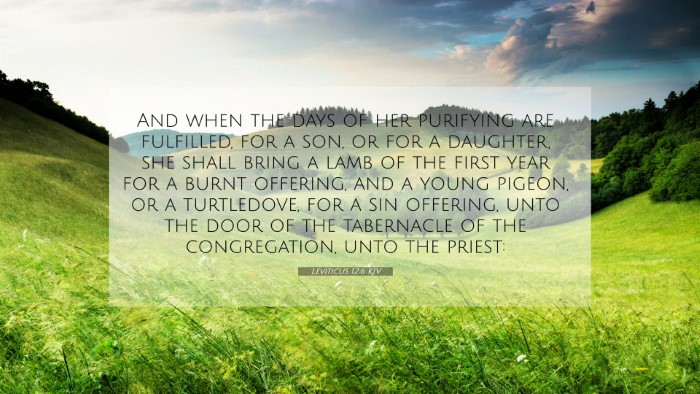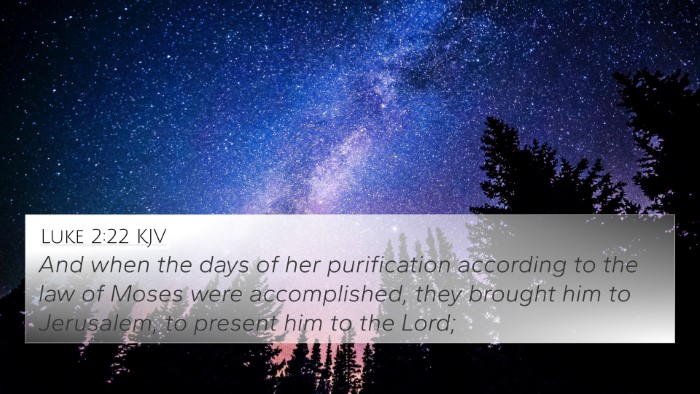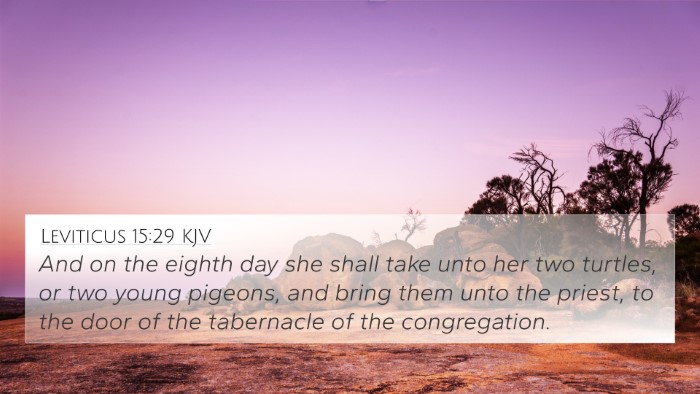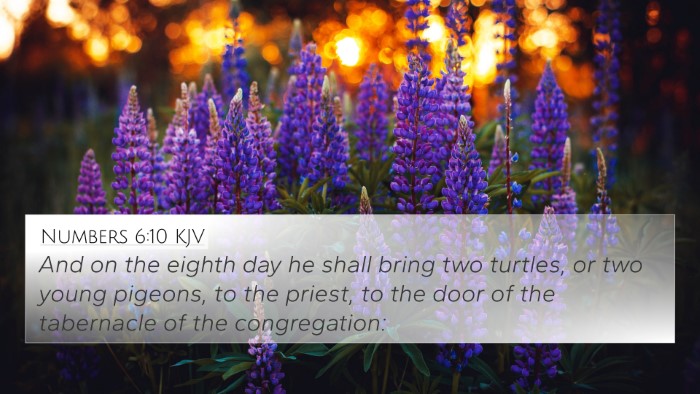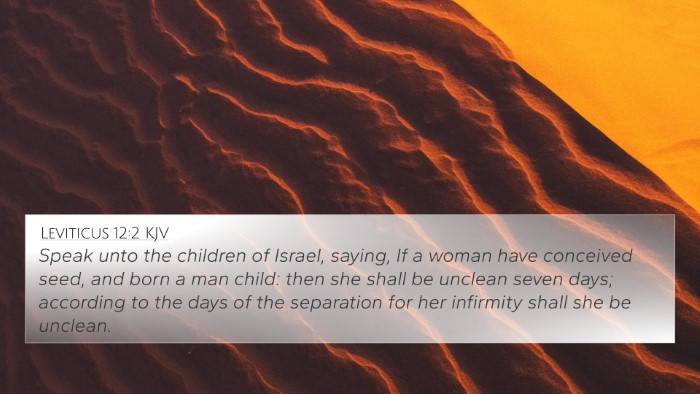Understanding Leviticus 12:6
Leviticus 12:6 states:
"And when the days of her purifying are fulfilled, for a son or for a daughter, she shall bring a lamb of the first year for a burnt offering, and a young pigeon or a turtle dove, for a sin offering, unto the door of the tabernacle of the congregation, unto the priest."
Summary of Meaning
This verse addresses the purification process for women after childbirth. It outlines the specific offerings that are required as part of this ritual in the Old Testament Law. Below are insights into its significance drawn from various public domain commentaries:
Insights from Commentaries
-
Matthew Henry:
Henry emphasizes the importance of purification after childbirth, highlighting both the physical and spiritual implications. The offerings reflect the mother's gratitude and recognition of God's mercy in childbirth, as well as the ongoing need for atonement, symbolized by the sin offering.
-
Albert Barnes:
Barnes elaborates on the symbolic meanings of the offerings. The lamb signifies a full-sized offering indicating a significant act of devotion, while the bird offerings (pigeon or turtle dove) suggest humility and accessibility for those who could not afford a lamb, thus representing God's grace and provision.
-
Adam Clarke:
Clarke points out that the law serves as a means of maintaining social order and cleanliness within the community. He suggests that the command indicates a concern for both physical health and spiritual wellness, aiming for a return to holiness after the birth of a child.
Cross-References for Leviticus 12:6
Leviticus 12:6 is interconnected with several other scriptures, highlighting themes found throughout the Bible:
- Luke 2:22: The presentation of Jesus at the temple, where Mary offers the required sacrifices, mirrors the practices outlined in Leviticus.
- Exodus 13:2: Calls for the sanctification of the firstborn, showing the importance of offerings as acts of obedience.
- Numbers 18:15-16: Discusses the redemption of the firstborn, again connecting to themes of purification and sacrifice.
- Hebrews 10:1-4: Reflects on the nature of sacrifices under the law, hinting at the greater sacrifice of Christ.
- Genesis 3:16: Highlights the consequences of the fall and the struggle in childbirth, providing context for the need for purification.
- Psalm 51:5: Addresses the inherent sinfulness of humanity, underscoring the necessity of sin offerings.
- Matthew 5:17: Jesus confirms that He came to fulfill the law, indicating the transitional nature of these rituals.
- Mark 1:44: Jesus instructing the healed man to offer the sacrifice as prescribed in the Law of Moses speaks to the ongoing relevance of these practices.
- 1 Peter 2:9: The call for believers to be a holy priesthood is a connection from Old Testament practices to New Covenant realities.
- Romans 12:1: Presents the idea of presenting ourselves as living sacrifices, reflecting on the transition from animal sacrifices to our lives as offerings.
Thematic Connections
The themes in Leviticus 12:6 resonate with broader biblical concepts such as:
- Purification and Atonement: Central to the sacrificial system and culminating in Christ's ultimate sacrifice.
- Community and Holiness: The societal implications of personal purification and its role in the collective sanctification of Israel.
- Grace and Accessibility: God's provision for both the wealthy and the poor in terms of acceptable offerings highlights the inclusive nature of divine grace.
Conclusion
Leviticus 12:6 symbolizes more than just a law; it encapsulates themes of gratitude, atonement, and the human condition as understood in both the Old and New Testaments. Understanding the connections between these verses, and their implications forms a foundation for deeper theological study and personal reflection.
SEO Keywords Utilized
This structured interpretation integrates key phrases such as Bible verse cross-references, Connections between Bible verses, and Comparative Bible verse analysis to enhance searchability and accessibility for those seeking to understand the depths of Leviticus 12:6 and its relational scripture.


